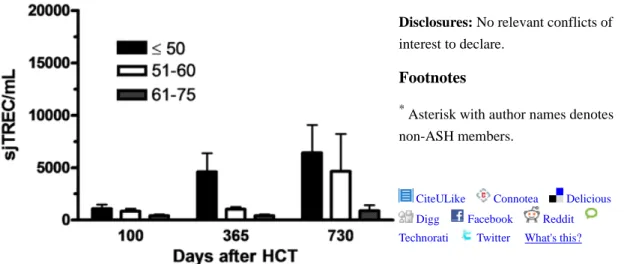This Article
Services Email this article to a friend Download to citation manager
Citing Articles Citing Articles via Google Scholar
Google Scholar Articles by Castermans, E. Articles by Baron, F. Search for Related Content
PubMed Articles by Castermans, E. Articles by Baron, F. Social Bookmarking What's this? SEARC H: Advanced
Blood (ASH Annual Meeting Abstracts) 2009 114: Abstract 1149
© 2009 American Society of Hematology Poster Session
CLINICAL CARE - ACUTE AND CHRONIC GVHD, INFECTIOUS COMPLICATIONS AND IMMUNE RECONSTITUTION OF TRANSPLANTATION POSTER I
Thymic Recovery After Allogeneic
Hematopoietic Cell Transplantation with
Nonmyeloablative Conditioning Might Be
Limited to Patients Younger Than 60 Years
of Age.
Emilie Castermans*,1, Muriel Hannon*,1, Remi Cheynier*,2,
Laurence Seidel*,3, Stéphanie Humblet-Baron*,1,
Evelyne Willems*,1, Stephanie Corbier*,1, Andre Gothot*,4,
Vincent Geenen*,5, Brenda M. Sandmaier6, Rainer F Storb6,
Yves Beguin*,1 and Frederic Baron1
1 Hematology & GIGA reserach, University of Liège, Liege, Belgium, 2 Department of Virology, Institut Pasteur, Paris, France,
3
Statistics, University of Liège, Liege, Belgium,
4
Laboratory Medicine, University of Liège, Liege, Belgium,
5 Center of Immunology, University of Liège, Liege, Belgium,
6 Fred Hutchinson Cancer Research Center and University of Washington, Seattle, WA, USA
Abstract 1149 Poster Board I-171
Background: Nonmyeloablative conditioning followed by allogeneic hematopoieticcell transplantation
(HCT) has been increasingly used as treatmentfor elderly patients with hematologic malignancies. It has beensuspected that T cell reconstitution would be impaired in elderlypatients given nonmyeloablative conditioning because of age-relatedthymic atrophy. Here, we investigated long term lymphocyte
reconstitutionand thymic function in 80 patients given allogeneic peripheralblood stem cells (PBSC) after nonmyeloablative conditioning.
Patients and Methods: Median age at transplant was 57 years (range 10-71). Conditioningregimen
consisted of 2 Gy total body irradiation (TBI) with(n=46) or without (n=20) added fludarabine, 4 Gy TBI with fludarabine(n=6), or cyclophosphamide plus fludarabine (n=8). Thirty-threeof the 80 patients received grafts from HLA-matched relateddonors, 22 from HLA-matched unrelated donors, and 25 from
HLA-mismatchedrelated or unrelated donors. PBSC were unmanipulated in 56 patients,CD8-depleted in 19 others, and CD34-selected in the remaining5 patients. GVHD prophylaxis consisted of mycophenolate mofetiland cyclosporine or tacrolimus. Immune recovery was assessedbetween 1 and 8.5 years after HCT by signal-joint T-cell receptorexcision circle (sjTREC) quantification (221 samples), and flowcytometry. Further, in order to demonstrate a potential thymicrecovery, sjTREC level changes from day 100 to days 365 and730 were also assessed by using Wilcoxon signed rank tests.
Results: There was a close correlation between sjTREC levels and naiveCD4+ T cells (defined as
Thymic Recovery After Allogeneic Hematopoietic Cell Transplantatio... http://abstracts.hematologylibrary.org/cgi/content/abstract/114/22/114...
Figure 1. Evolutionof sjTREC concentration according to patient age at HCT.
CD4+CD45RA+) counts (P<0.0001).An inverse correlation was observed between the levels of sjTREC/ml and the recipient's age (R=-0.41, p<0.0001). Interestingly,sjTREC levels increased from day 100 to 1 and 2 years aftertransplantation in patients 50 (n=23; P=0.02 and P=0.04, respectively),and in those 51-60 years of age (n=35; P=0.17 and P=0.06, respectively),but not in patients >60 (n=22; P=0.3 and P=0.3,
respectively)(Figure 1). Similarly, naïve CD4 T cell counts increasedfrom day 100 to 1 and 2 years after transplantation in patients 50 (n=23; P=0.01 and P=0.3, respectively), and in those 51-60years of age (n=35; P=0.5 and P<0.001, respectively), butnot in patients >60 (n=22; P=0.9 and P=1.0, respectively).In multivariate analyses, older patient age (P<0.001), extensivechronic GVHD (P<0.001), and prior (resolved) extensive chronicGVHD (P=0.008) were associated with low sjTREC levels, whileolder patient age (P<0.001), and extensive chronic GVHD (P<0.001)were associated with low naïve CD4 T cell counts.
Conclusions: Our data suggest that thymic neo-generation of T cells occurredfrom day 100 onwards in
patients under 60. However, the levelsof sjTREC remained low for patients above 60. Further, chronic GVHD has a dramatic impact on thymic function, as observed aftermyeloablative conditioning.
Disclosures: No relevant conflicts of
interest to declare.
Footnotes
* Asterisk with author names denotes non-ASH members.
CiteULike Connotea Delicious
Digg Facebook Reddit
Technorati Twitter What's this?
Copyright © 2009 by American Society of Hematology Online ISSN: 1528-0020
Thymic Recovery After Allogeneic Hematopoietic Cell Transplantatio... http://abstracts.hematologylibrary.org/cgi/content/abstract/114/22/114...
